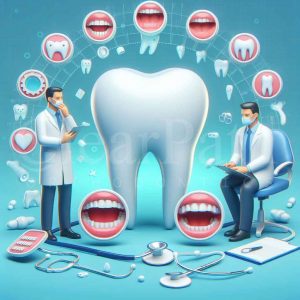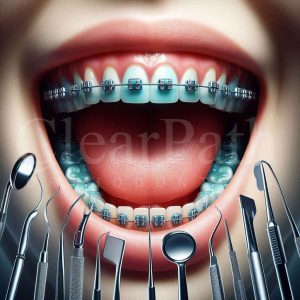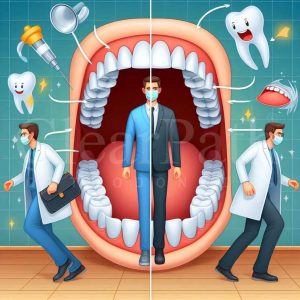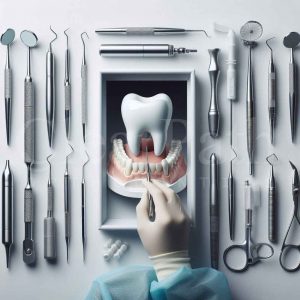Have you ever wondered what the difference is between a dentist and an orthodontist?
If you’re like most people, you probably use these terms interchangeably, without knowing that they actually refer to different specialties in oral health care.
In fact, according to a survey by the American Association of Orthodontists, only 35% of Americans know that all orthodontists are dentists, but not all dentists are orthodontists.
According to Google Trends, some of the most popular searches related to dentistry and orthodontics are:
– Can my dentist fix my overbite?
– Do I need an orthodontist if my teeth are crooked?
– What is the difference between a dentist and an orthodontist?
These questions show that there is a lot of confusion about the roles and responsibilities of these two dental professionals.
And this confusion can have serious consequences for your oral health and your smile. You might end up choosing the wrong provider for your needs, or you might delay getting the treatment you need.
Let’s unravel the mystery and set the record straight.
So what exactly is the difference, and why does it matter?
Table of Contents
ToggleDentistry Vs Orthodontics

We will explain how they differ in terms of education, specialization, and scope of practice.
By the end of this post, you will have a clear idea of when to see a dentist and when to see an orthodontist.
Let’s find out.
Common Misconceptions

It’s a common conundrum – dentist or orthodontist? Search queries like “Can my dentist fix my overbite?” certainly reflect the confusion.
This mix-up could lead to choosing the wrong professional or delaying essential treatment, affecting your oral health
Welcome to our guide, a beacon of clarity in the sea of dental ambiguity. We promise to demystify the roles of dentists and orthodontists, helping you make informed decisions about your oral care.
Let’s start with the basics.
What is Dentistry?
Dentists are your go-to professionals for a wide range of oral health needs.
Dentistry is the branch of medicine that deals with the health of your teeth, gums, and mouth and a dentist is a general practitioner who can diagnose, treat, and prevent various dental problems.
Procedures that Dentists Offer
From cleanings and fillings to root canals and crowns, they’re your first line of defense against dental issues. Some dentists even offer basic orthodontic services, like clear aligners for minor misalignments.
Some of the common procedures that dentists perform are:
| Procedures Offered by Dentists | Description |
| Fillings | Dentists use materials like composite resin or amalgam to fill cavities and restore damaged teeth. |
| Cleanings | Dentists use special tools to remove plaque and tartar from your teeth and gums, preventing tooth decay and gum disease. |
| Root canals | Dentists remove the infected pulp from the inside of your tooth and seal it with a filling or a crown to save it from extraction. |
| Crowns and bridges | Dentists use artificial teeth to replace missing or damaged teeth. Crowns cover the entire tooth, while bridges span the gap between two or more teeth. |
However, dentists are not trained or certified to perform complex orthodontic treatments like braces or surgery.
That’s where orthodontists come in.
What is Orthodontics?
Now, let’s zoom in on orthodontists, the specialists in tooth alignment and jaw development.
Orthodontics is a branch of dentistry that specializes in the diagnosis, prevention, and treatment of irregularities in the alignment of the teeth and jaws.
With an additional 2-3 years of training post-dental school, they’re the experts in diagnosing and treating complex bite problems, malocclusions, and jaw discrepancies.
Braces, clear aligners, and even jaw surgery fall within their realm.
Orthodontists are experts in dealing with complex cases of malocclusion (bad bite), such as overbite, underbite, crossbite, open bite, crowded teeth, and spacing issues. They also have the skills and knowledge to correct jaw discrepancies that affect facial growth and appearance.
Common Orthodontic Treatments
Orthodontists use various appliances and techniques to straighten teeth and improve jaw function.
Some of the common orthodontic treatments include:
| Common Orthodontic Treatments | Description |
| Braces | Metal or ceramic brackets that are attached to the teeth and connected by wires and elastics. Braces apply gentle pressure to the teeth to gradually move them into the desired position. |
| Clear aligners | Removable plastic trays that fit snugly over the teeth and are virtually invisible. Clear aligners are changed every few weeks to progressively shift the teeth. |
| Jaw surgery | A surgical procedure that involves cutting and repositioning the bones of the upper or lower jaw to correct severe bite problems or facial asymmetry. |
Direct Comparison
Education, specialization, procedures let’s lay it all out.
We’ll debunk common misconceptions, like the notion that any dentist can straighten your teeth.
Spoiler alert: it’s not that simple.
While both dentists and orthodontists are concerned with oral health and aesthetics, there are some key differences between them.
Here are some of the main aspects that distinguish them:
Education: Dentists complete four years of dental school after obtaining an undergraduate degree. Orthodontists complete four years of dental school plus an additional 2-3 years of residency in an accredited orthodontic program.
Specialization: Dentists provide a wide range of services that cover all aspects of general dentistry, such as preventive care, restorative care, cosmetic dentistry, oral surgery, endodontics, periodontics, and prosthodontics. Orthodontists focus exclusively on orthodontics and treat only patients who need tooth alignment or jaw correction.
Procedure: Dentists perform various procedures that involve cleaning, filling, extracting, repairing, or replacing teeth. Orthodontists perform procedures that involve moving teeth or jaws using braces, clear aligners, or surgery.
The main differences between a dentist and an orthodontist are listed below.
| Dentist | Orthodontist |
| Dentists are doctors of oral health | Orthodontists are also doctors of oral health but they specialize in diagnosing and treating misalignments of your teeth and jaws. |
| They diagnose and treat conditions of your gums, teeth, tongue, and mouth | They supervise facial growth (jawline and bite) in children, diagnose and treat misaligned teeth and jaws, create a treatment plan that includes braces and retainers, perform teeth straightening surgery, and install dental appliances. |
| They conduct and interpret dental X-rays, fill cavities, extract teeth, repair cracked teeth, promote oral health and oral hygiene, fill and bond teeth, treat gum disease, prescribe treatment for oral health conditions, whiten teeth, install crowns or veneers, oversee the development of children’s teeth, and perform oral surgery | Orthodontists undergo additional specialized training in tooth alignment after completing dental school. Orthodontists work with patients to correct misalignments, overbites, underbites, and overcrowded teeth. |
| Dentists provide general oral health care, including routine check-ups, cleanings, fillings, and root canals | They recommend and install braces and other tooth alignment treatment plans to help patients fix the appearance of their teeth. |
In summary, while both dentists and orthodontists help patients maintain their oral health, dentists provide general oral health care, and orthodontists specialize in correcting teeth and jaw misalignments.
Benefits of Seeing the Right Professional

Choosing the right professional is crucial for accurate diagnosis and effective treatment.
Early intervention by an orthodontist can prevent future complications, while seeing the wrong professional may mean neglecting underlying dental issues or receiving inadequate orthodontic treatment.
Here are some of the benefits of seeing an orthodontist for your orthodontic needs:
Proper diagnosis: An orthodontist can accurately identify the root cause of your bite problem and determine the best course of action. An orthodontist can also detect any underlying dental issues that may affect your orthodontic treatment or outcome.
Customized treatment plan: An orthodontist can design a personalized treatment plan that suits your specific needs and goals. An orthodontist can also offer a variety of options to suit your preferences and budget.
Optimum results: An orthodontist can ensure that your teeth and jaws are aligned properly and function harmoniously. An orthodontist can also enhance your facial balance and aesthetics by improving your profile and smile.
Concerns

On the other hand, seeing the wrong professional for your orthodontic needs can pose some risks, such as:
| Consequences of Choosing the Wrong Professional | Description |
| Neglecting underlying dental issues | A dentist who is not trained in orthodontics may not be able to detect or treat any dental problems that may interfere with your orthodontic treatment or outcome. For example, if you have gum disease or tooth decay, you may need to address those issues before starting any orthodontic treatment. |
| Receiving inadequate orthodontic treatment | A dentist who is not trained in orthodontics may not be able to provide you with the best possible solution for your bite problem. For example, if you have a severe overbite or underbite, you may need more than just clear aligners or simple braces to correct it. You may need more advanced appliances or surgery to achieve optimal results. |
| Experiencing complications or dissatisfaction | A dentist who is not trained in orthodontics may not be able to monitor your progress or adjust your treatment as needed. You may experience complications such as pain, infection, tooth damage, or relapse. You may also be unhappy with the final outcome of your treatment if it does not meet your expectations or standards. |
One of the common misconceptions that people have is that all dentists can straighten teeth.
While some dentists may offer basic orthodontic services, such as clear aligners or simple braces, they do not have the same level of training and experience as orthodontists.
Only orthodontists are qualified to handle complex cases that require precise diagnosis and treatment planning.
In a nutshell, dentists and orthodontists serve distinct roles. Dentists cover a broad spectrum of oral health, while orthodontists specialize in alignment. Choose wisely based on your specific needs for optimal results.
If you are looking for an orthodontist who can help you achieve a healthy and beautiful smile, look no further than ClearPath’s panel of expert orthodontists.
ClearPath is a leading provider of clear aligners that are comfortable, convenient, and affordable. ClearPath aligners are custom-made to fit your teeth and gently move them into the desired position. ClearPath aligners are also removable, so you can eat, drink, brush, and floss normally.
As a dentistry professional, if you are intrigued by the prospect of becoming a ClearPath affiliate and boosting your practice’s client profile, please fill out the form below.
Our friendly customer service agents will reach out to guide you on the next steps. All your information will be kept private.











